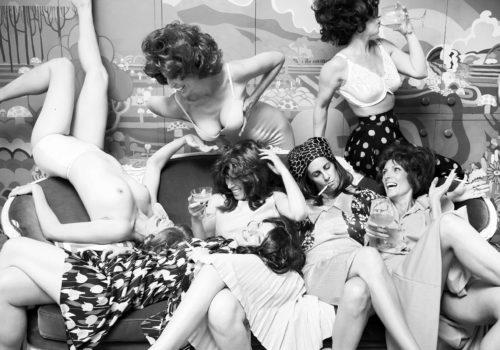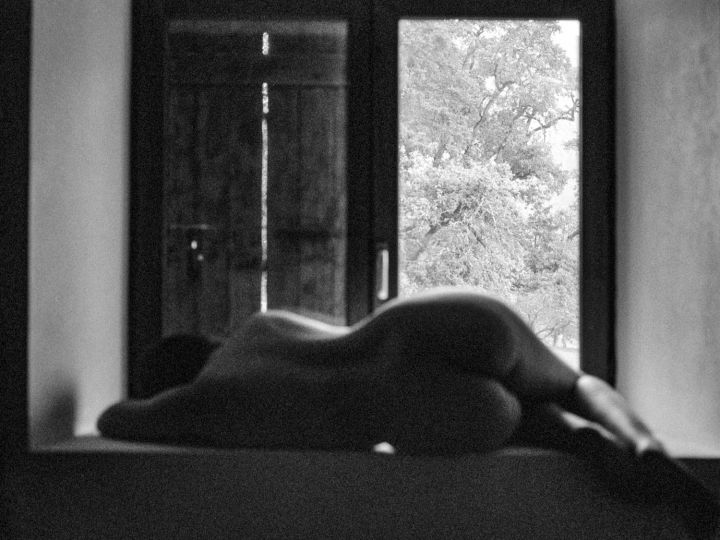Named one of Lens Cultures top 50 Emerging Artist, Marjorie Salvaterra’s images reveal “a fine line between sanity and insanity,” according to Virginia Heckart, Associate Curator of Photography at The Getty Center.
Salvaterra’s exhibitions include: The California Museum of Art ( Making Pictures Of People), The Nelson-Atkins Museum / Flak Photo, Nuits des Images Musée de l’Élysée; the “Human + Being” show at The Center for Fine Art Photography; Rencontres d’Arles, Arles, France, Solo exhibits at Ralph Pucci (Los Angeles, New York City and Miami), Van Rensburg Galleries, Australia, and The Griffin Museum of Photography. Her work was included in PDN’s Emerging Photographers, Black and White Magazine and she was runner-up for the Berenice Abbott Prize for Emerging Photographers and a finalist for Critical Mass.
Her book “HER: Meditations On Being Female” was published in May 2016 by Glitterati Incorporated.
Marjorie’s great achievement is as a wife and a mother of two. She makes her home in Los Angeles, California.
Website: www.marjoriesalvaterra.com
BOOKS: https://www.amazon.com/Her-Meditations-Female-Marjorie-Salvaterra/dp/194387610X
https://geditionsllc.com/products/her-meditations-on-being-female
EXHIBITIONS: https://ralphpucci.com/exhibitions-cat/new-york-penthouse/
https://ralphpucci.com/exhibitions/current-la-showroom/
Lanza: Discuss how and why your photographic, artistic work has come to focus on Women?
Salvaterra: My work started to focus on women the day I had the first photo in my head for my HER series. I was going through a lot at the time and I had the image in my head of all the women standing in the water, all dressed up, and the idea of one drop of water throwing everything off. It was like everything I was feeling arrived in picture form in my head. I started the series based on that. I was taking a project class at the time with Aline Smithson of LENSCRATCH, and my photos were unlike anyone else’s in the class––more surreal and quirkier. I went to Aline after the class and said, “I don’t think I belong here.” She would not let me quit! And each week, I came back with new images, that were still very different. As I started to understand the story I was telling, I began to see that if I told stories that were unique to me, my work would be also unique to me. But what surprised me most was the way others began to connect. I had been feeling very alone in the idea that I was having trouble balancing life as a wife, mom, woman, sister, daughter, friend. And suddenly there were a whole group of other humans that were saying “I so relate to this.”
Lanza: Your work challenges old opinions, a window into the culture of being female. How has this narrative evolved?
Salvaterra: I think the older I get, I have more understanding of who I am, and more understanding of my own parents. Who they were and why they were the way they were. Also, why they did the things they did — based on the stories that were told to them of who they were “supposed” to be. I also grow every day as a parent. I certainly have days when I do everything wrong, but I’m open to learning through all the ups and down.
And yet, every day that the idea of womanhood evolves, we are still left with the same basic stories. We still need to learn boundaries as women-it seems unlike men. We can be feminine and strong. And take care of us, without having to put up walls. We can say no and be okay. We can get what we want by knowing what we don’t want. And we can be messy and clumsy and that’s okay too. We can be accepting of our flaws, even as they stare back at us in the mirror. We don’t have to love everything about ourselves. We can love the fact that we still show up, despite everything else going on in our lives and around us.
Lanza: Who and or what has been influential in your process and this subject?
Salvaterra: This is a huge question. My photographic journey didn’t begin until my 30’s. I like to say this is my third career! So going to the beginning, the photographer Richard Cartwright really was the first to tell me I had a good eye, and he referred me to Julia Dean, who became my teacher and mentor. I took every class she taught at the time. I just loved being in class, surrounded by creative, wonderful people — many who have gone on to great careers in photography and that have also ended up in my photos! I am influenced by my life, my family, my husband, my kids, my parents and sister and my friends, who continue to show up for all my crazy ideas… sometimes dressed and sometimes not. They are moms and lawyers and fellow photographers and teachers and nannies and life coaches…
I always shoot very quickly. In preparation, by the time I show up for the shoot, most of the work is done. At that point it’s just getting the idea from my head into my camera. And I’m very aware of everyone giving me their time. So, we shoot, then go get coffee and talk about it. We discuss relationships and life. We scroll dating apps with my younger models. I give lots of dating advice — whether asked for or not. And we talk about our kids and our spouses and sex and books and women’s issues and all our aches and pains. I highly recommend showing up for a shoot. We truly have the best time. And all these moments somehow end up in my work.
Lanza: Describe how your photographic work has developed, in technique and process.
Salvaterra: I’m not a very technical person. I work with one basic camera and it took me ten years to shoot on manual. These days I mostly used my Sony Alpha A7rii. Nothing fancy but I do set it on manual and adjust to my lighting. I do most of my own printing in my little office at home, which is also my son’s 3D printing space, my husband’s desktop space, my dog’s crate, and my daughter’s artwork. I have just enough room for a 44” Canon pro printer but I may upgrade to the 60” — with the belief that bigger is always better.
Lanza: How did your book publication titled, HER occur?
Salvaterra: The Palm Springs Photo festival it’s a two-hour drive from Los Angeles. They always have amazing reviewers and I was fortunate to meet with Marta Hallett of Glitterati Inc. I had never thought of a book of my work but within the first minute of showing her an image, she said, “I’m making this book.”
Shockingly, she had the book out within nine months. She had published so many gorgeous books so I trusted her completely. All I did was send the images and summary of each series and Marta did her magic. The book turned out beautifully.
Lanza: Your series titled SHINE is currently exhibiting in New York and Los Angeles, where are you looking to tour the show?
Salvaterra: My amazing publisher, Marta Hallett had sent my book to one of her clients, Ralph Pucci. She said I think you’ll love this artist and Ralph said he was opening his new gallery in LA. Marta sent him my book. I was sitting at breakfast with Ralph and he asked if I could have 20 pieces ready in two weeks. That was five years ago and I’ve been showing at his galleries in Los Angeles, New York, and Miami every year since. My new series SHINE is currently up in the New York and Los Angeles galleries. Two of the most beautiful spaces in the country. And everyone who works at Pucci is so creative and professional.
I’d love to start exhibiting in museums and shown internationally especially in European venues.
















